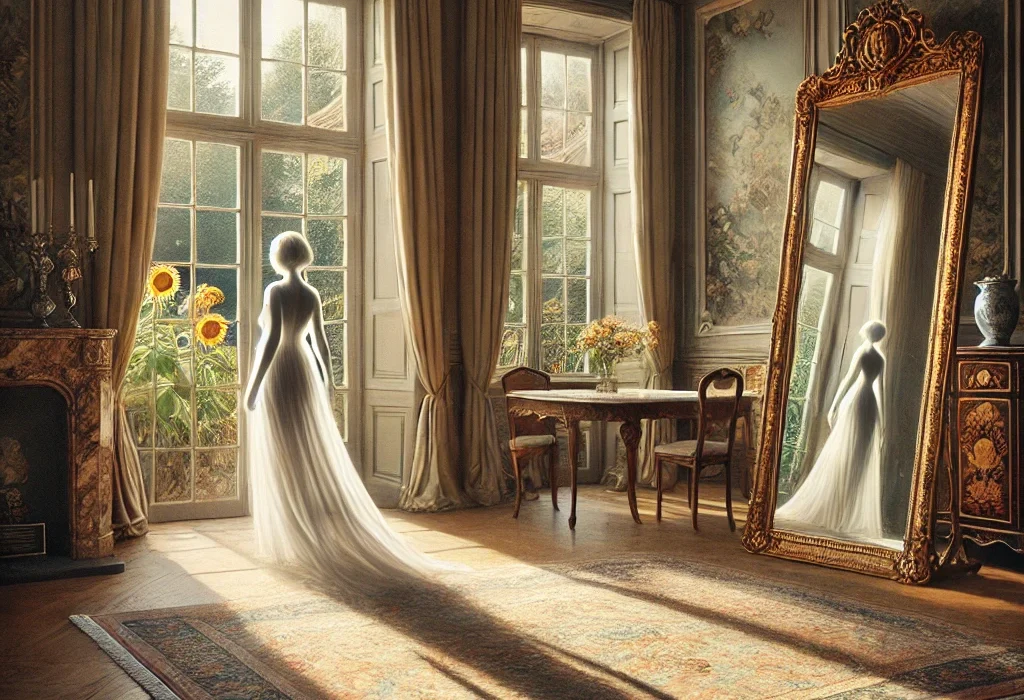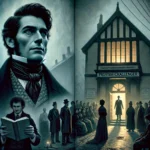“The Lady in the Looking Glass” by Virginia Woolf, published in 1929, is a reflective and evocative short story that explores the elusive nature of identity and the limitations of perception. Set in the stillness of a solitary room in a grand house, the story offers a nuanced portrait of its central character, Isabella Tyson, while employing a rich interplay between reality and appearance. Woolf’s narrative oscillates between the observations made through a looking glass and the perceptions of the narrator, weaving a complex study on selfhood and the essence of truth.
Plot Summary
In the quiet of a grand, aging house, a long mirror stands in the hall, framing a silent world that appears to transcend time. Reflected within its glass is a marble-topped table, surrounded by shadows of the room and the lush greenery of the garden beyond. Here, in this tranquil and undisturbed setting, a solitary figure moves, unseen, along the grass path outside. This figure, Isabella Tyson, is a woman whose mystery is not merely an aspect of her bearing but seems to be woven into her very being, obscured behind layers of elegance and decorum.
Isabella, a woman in her mid-fifties, is known for her grace and worldly possessions, all collected through her travels and adventures. The room in which she lives is filled with items gathered from distant lands—cabinet drawers that likely hold letters, memories, or secrets, now locked and hidden from sight. Yet, for all her acquired wealth, Isabella is not one to indulge in loud displays of grandeur. Her life is wrapped in quiet restraint, a shroud of privacy that few, if any, have ever pierced. Her acquaintances may know her habits, but of the truth beneath, they know very little. To those who observe her from a distance, she is an enigma, a figure defined as much by what she conceals as by what she reveals.
The hall mirror, an inanimate witness, reflects the contrast between the room’s stillness and the ever-shifting quality of light and shadow that breathes through it. The room seems alive, filled with imagined presences that flit across the floors and walls—dancing shapes, hints of colors, and faint echoes of emotions, all stirring in the silence. These transient impressions bring to life the long-dormant passions, regrets, and quiet sadness that lie just beneath the polished surface of Isabella’s existence. And so, the room itself becomes a mirror of sorts, holding the unseen parts of Isabella’s life, parts as shadowed and locked away as the letters in her cabinets.
Once, half an hour before, Isabella was seen walking down the garden path, carrying a basket and dressed in a thin summer gown. She had vanished beyond the edge of the mirror’s reflection, leaving her absence in the room as a quiet echo. Perhaps she had gone to pick flowers, or perhaps she had wandered there to gather something more elusive, something akin to the delicate beauty of the blooms she adored. Her presence in the garden, framed by the splendor of the roses and lilies, was as ethereal as the flowers she tended—a fleeting, graceful image, full of beauty yet hauntingly insubstantial.
The mirror, ever-watchful, sees more than mere physical presence; it reflects the assumptions and imaginings of those who look into it. To one observer, Isabella’s image takes on a life beyond her reality—a fantasy constructed from fragments of her life, as reflected by her graceful gestures, her thoughtful solitude, and the aura of her unspoken desires. This observer attempts to peer into her soul through the mirror, seeking to understand the essence of her character, to pry open the mystery of her life with nothing more than a gaze.
Yet, beneath this surface of elegance and quiet beauty, something intangible but persistent suggests that there is more to Isabella’s life than mere grace and decorum. She is a woman who, though never married, has known the heights of passion and the depths of sorrow, a woman whose relationships are scattered across continents and whose memories are captured in letters and mementos. These letters, lying carefully stowed away in her drawers, seem to bear the weight of emotions too profound and experiences too personal to be shared with others. The fragments of her life suggest a rich inner world, complex and tumultuous, veiled beneath a serene exterior.
Then, with an unannounced interruption, the scene shifts. A postman arrives, his presence only a fleeting silhouette in the mirror. He brings letters, laying them on the marble-topped table, their stark presence breaking the stillness of the room. Each letter, sealed and silent, carries within it the potential to disrupt the calm of Isabella’s life. Their quiet arrival signals the intrusion of the outside world, reminding Isabella—though she has yet to reappear—that life is not a series of controlled impressions but rather a collection of moments that cannot always be held within the walls of the self.
At last, Isabella appears in the frame of the mirror, returning with her basket. Her movement is calm, her manner unhurried, and as she approaches the table, she pauses, the light from the hall settling upon her. She seems momentarily transfixed, caught between the visible world and the unseen truth that lies hidden within her. The mirror captures her with a piercing clarity, as if stripping away every veneer and exposing the raw, unembellished self beneath. The sparkle of her jewelry, the fineness of her clothing—all fade away, leaving only the bare reality of her being.
In this sudden clarity, all the imagined layers, all the hints of romance, adventure, and mystery dissolve. The grand assumptions about her complex life, her hidden passions, her indomitable will—all are laid bare and found empty. There is no concealed joy, no deep sorrow, no profound wisdom or poignant regret. The letters are nothing more than bills, records of transactions, mundane notes of an ordinary life. The drawers that were once imagined to hold the secrets of a world-traveling life appear instead to hold little of significance, and Isabella herself stands stripped of any illusions, as devoid of hidden depths as the plain walls around her.
For a moment, the reflection of Isabella stands frozen, her empty gaze fixed upon her own image. She is no longer the mysterious woman of romance, elegance, and hidden passions but simply a solitary figure, a person like any other, whose life is as much defined by absence as by presence. The observer realizes that the desire to define her, to shape her character into something grand and unknowable, has been an exercise in futility. Her life, like the stillness of the room and the fixed reflection in the mirror, holds no answers beyond the ones visible to the eye.
In the end, Isabella turns, moving slowly out of the frame of the mirror, leaving behind only her faint reflection in the hall’s quiet space. The mirror remains, untouched and undisturbed, its surface unmarred by the fleeting presence it held. In its silent depths, it holds no more than the unembellished truth: that Isabella Tyson is not a figure of mystery but rather a mere reflection, an image shaped as much by those who observe her as by the reality of her own life.
Main Characters
Isabella Tyson: A wealthy, solitary spinster in her mid-fifties, Isabella embodies mystery, privacy, and hidden depths. Though she is admired for her elegance and material possessions, she appears emotionally elusive and enigmatic. Woolf portrays Isabella as a woman of refined tastes, marked by her silent introspection, but also hints at an underlying emptiness beneath her refined facade.
The Narrator: An anonymous observer who watches Isabella through the looking glass, the narrator acts as a proxy for the reader, projecting assumptions and imaginings onto Isabella. This character’s role in the narrative emphasizes the subjectivity of perception, as the narrator seeks to uncover Isabella’s inner life, ultimately confronting their own limitations in understanding her.
Theme
Illusion vs. Reality: Woolf explores the distinction between how things appear and what they truly are. Through the looking glass, Isabella’s life seems filled with elegance and vibrancy, yet the narrator’s eventual revelation of her empty, unfulfilled existence challenges these assumptions, underscoring the disparity between appearance and inner truth.
Solitude and Isolation: Isabella’s life of wealth and refinement masks her profound loneliness. Although she is surrounded by beautiful objects, she appears disconnected from genuine relationships or personal attachments, embodying a haunting solitude that permeates the story.
The Nature of Identity: The story questions whether one’s true self can ever be fully known, even to oneself. The narrator’s shifting perceptions of Isabella underscore the complex, often inaccessible layers of identity, suggesting that attempts to “define” someone inevitably fall short of capturing their full essence.
The Power of Observation: Woolf uses the looking glass as a symbol of the invasive nature of observation, as well as its limitations. While the narrator seeks to dissect Isabella’s character through observation, the process only reveals the impossibility of truly seeing someone’s inner life, thus illuminating the flawed nature of outward judgments.
Writing Style and Tone
Virginia Woolf’s writing style in “The Lady in the Looking Glass” is introspective, lyrical, and richly symbolic. She employs a stream-of-consciousness narrative, blending the narrator’s reflections with vividly descriptive prose that captures both the tranquility and tension within the house and the garden. Her language often evokes a dreamlike, almost hypnotic quality, drawing readers into a world of shifting perceptions and subtle revelations. The story’s diction is lush and evocative, filled with metaphorical images—such as descriptions of Isabella’s surroundings that seem almost alive, embodying her unspoken thoughts and memories.
The tone is contemplative and introspective, underscoring the story’s exploration of deeper existential questions. Woolf’s narration carries an air of melancholy, emphasizing the theme of isolation and the human yearning to be truly seen. By gradually peeling back the layers of Isabella’s life, Woolf imbues the story with a haunting beauty, leaving readers with a profound sense of the limitations of both observation and understanding.
We hope this summary has sparked your interest and would appreciate you following Celsius 233 on social media:
There’s a treasure trove of other fascinating book summaries waiting for you. Check out our collection of stories that inspire, thrill, and provoke thought, just like this one by checking out the Book Shelf or the Library
Remember, while our summaries capture the essence, they can never replace the full experience of reading the book. If this summary intrigued you, consider diving into the complete story – buy the book and immerse yourself in the author’s original work.
If you want to request a book summary, click here.
When Saurabh is not working/watching football/reading books/traveling, you can reach him via Twitter/X, LinkedIn, or Threads
Restart reading!








